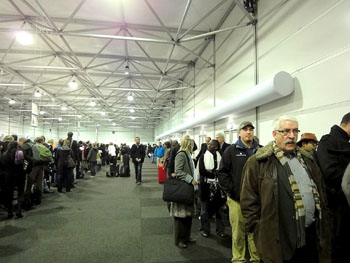On eve of global climate summit, it’s a street party
As 192 nations prepare to talk, lobby groups create festive atmosphere

Where’s Jesse? Jesse Tungilik, part of the Inuit Circumpolar Council delegation, was among hundreds of people who faced interminable waits to get into Copenhagen’s Bella Centre, the site of the 10-day United Nations conference on climate change. In this picture, you can see him waiting patiently behind the bespectacled man with the moustache. (PHOTO BY JANE GEORGE)

Jimmy Qamukaq of Igloolik, a performer with Artcirq, stands near a carving of a polar bear in Copenhagen’s Nytorv Square that will melt down to its metal bones as the United Nations climate change conference takes place over the next 10 days. (PHOTO BY JANE GEORGE
COPENHAGEN — On the eve of COP15, the much-anticipated United Nations conference where politicians, bureaucrats and scientists plan to spend the next 10 days negotiating a new global agreement to curb climate change, the mood in Copenhagen is more like that of a party than a grim deliberation over climate science and energy policy.
The centre of Denmark’s capital city is filled with dozens of gaudy displays set up by various lobby groups to communicate messages about climate change.
Jimmy Qamukaq of Igloolik, who is to perform with Artcirq at a special Arctic tent set up by the World Wildlife Fund in Copenhagen’s Nytorv Square, said a melting ice sculpture outside the WWF tent looked “cool.”
The sculpture is a transparent polar bear carved from an 11-tonne block of ice frozen over a bronze skeleton.
As the polar bear melts, its metal skeleton will appear, absorb heat and melt the ice even faster — a symbol of the accelerated warming that occurs when snow and ice disappear from the land and seas of the Arctic.
There are also giant globes marked to show the Earth’s global warming hot-spots, a huge ballon that shows what a tonne of greenhouse gas looks like, a banner saying “Our climate — Our Future — Your decisions” on Greenpeace’s Arctic Sunrise boat, fluorescent fake icebergs, and even a shipping crate decorated with a flashy message boasting that “Brad Pitt is saving the world.”
Nearby a group of activists dressed in bright red suits and eyeglasses parade around with signs that read “rich countries, pay your climate debt.”
They want to remind people that the UN conference in Copenhagen isn’t just about eye-catching street art and sideshows, but finding a way to save the world from baking.
For 10 days, bureaucrats, scientists and 100 national leaders, including U.S. President Barack Obama and Prime Minister Stephen Harper, will try to agree on how to limit the world’s production of greenhouse gas emissions, linked to global warming, to avoid a global temperature increase of two degrees Celsius.
The conference is called “COP15” because it’s the 15th time the various parties and governments have met to talk about climate change.
Just getting into the Bella Centre, where the conference will take place, took three hours on Sunday afternoon, as Jesse Tungilik, part of the Inuit Circumpolar Council delegation, found out as he waited outside in a long line.
Tungilik, an intern at the Indigenous Peoples Secretariat in Copenhagen, finally made it through stiff security outside, which had closed down completely earlier that day due to an alarm over an untended suitcase, to face even more security checks inside.
COP-15 was set to open on the morning of Dec. 7 and will close Dec. 18, with what may hope will be a political deal that will keep the Arctic from melting like the WWF’s representation of a polar bear.
They will attempt to agree on a way of cutting emissions by 60 to 80 per cent by 2020 to head off the worst effects of global warming and find ways to help developing countries achieve their targets through a possible transfer of billions of dollars a year in aid from rich to poor countries.
These political and financial questions now overshadow the scientific finds which, according to a recent scientific report called “The Copenhagen Diagnosis,” show surging greenhouse gas emissions, the accelerated melting of glaciers and ice-caps, and that the turning point in taking action to curbing greenhouse gas emissions must come soon.
But some say leaders may be reluctant, because according to the World Bank, the kind of action needed may cost $140 to $675 billion a year.
The costs of dealing with the impacts of climate change could run to another $75 billion a year.
Many Arctic leaders, including Nunavut Premier Eva Aariak, will be in Copenhagen to make sure the 15,000-plus registered participants from the 192 nations and non-government organizations attending the meeting don’t forget about the impact of global warming on the Arctic.
The Inuit Circumpolar Council wants to draw attention to its needs and establish the right of Inuit communities to benefit from a billion-dollar climate change adaptation fund that may be part of a new agreement.
There will be non-stop events at the WWF’s Arctic tent, as well as an event organized by the Inuit Circumpolar Council, and an Inuit Day.
Arctic youth have also endorsed a youth declaration to the conference that says:
“The battle against climate change is upon all of us. We are ready to act and we invite you to join us. Climate change is affecting our lives, our families and our future. We must act immediately and we are ready to fulfill our commitments. We are prepared to give all we have as long as there is the possibility of saving our planet. We expect the same courage from you.”
“I believe that negotiators now have the clearest signal ever from world leaders to draft a solid set of proposals to implement rapid action,” Yvo de Boer, the UN’s climate chief, told reporters on Dec. 6.
“Never in the 17 years of climate change negotiations have so many different nations made so many firm pledges together. Almost every day countries announce new targets or plans of action to cut emissions.”
But the world’s attention may be diverted from climate change by protests planned for Copenhagen where more than 10,000 people are expected to attend an “alternative climate forum.”
A group called Climate Justice Action is also calling for a “flood for climate justice” on Dec. 12, its global day for climate action.
“At the start of the high-level “ministerial” phase of the two-week summit, we, the movements for global justice, will take over the conference for one day and transform it into a Peoples Assembly. Our goal is to disrupt the sessions and open a space inside the UN area to hold the Assembly,” a statement from the group says.
On Dec. 13 the group wants to blockade Copenhagen’s harbor, what it calls “a key symbol of the global free-market economy.”
Activists have prepared for possibly violent confrontations and are trying to recruit doctors to help out in case some protestors are wounded.
Police, who now number about 6,500, plan to use a new water cannon to break up any demonstrations that turn violent.
They’ll also cart protestors off to a makeshift jail comprising 36 steel cages at a former beer warehouse, which can house up to 350 people at a time.
And they’ll be backed by new Danish laws that allow them to arrest and detain anyone who is disruptive.
As part of the $122-million security improvements, the perimeter of the Bella Centre has been closed off with high steel barricades and only registered delegates, media, NGO representatives can get in to the meeting.





(0) Comments